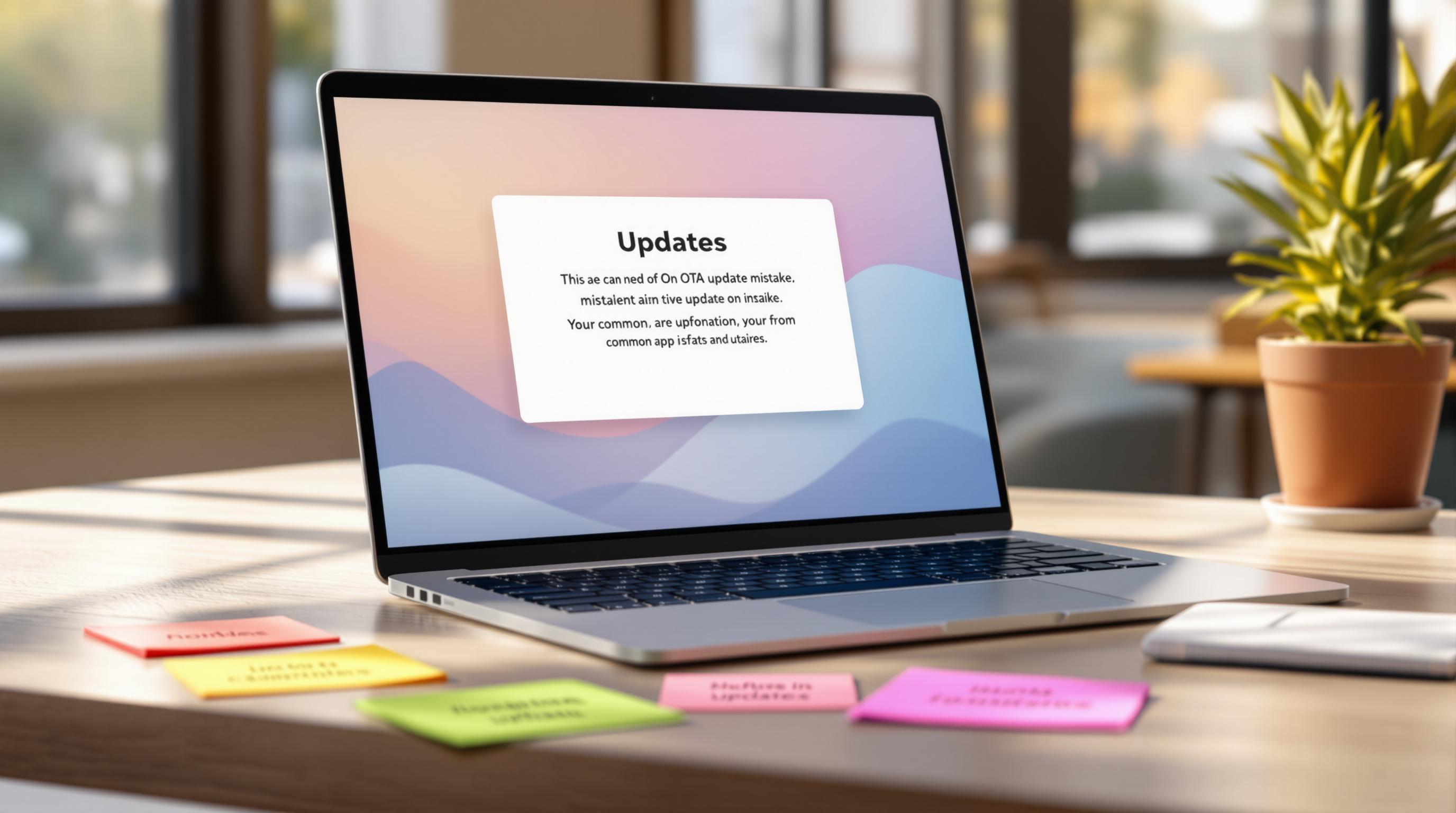CI/CD tools make over-the-air (OTA) updates faster, safer, and more reliable by automating the process. Here’s how:
- What Are OTA Updates? They let you update app assets like HTML, CSS, and JavaScript instantly via a CDN, skipping app store approval delays.
- How CI/CD Helps: Automation tools like GitHub Actions streamline key steps like build checks, security validation, and deployment, cutting errors by 72% and enabling same-day patches.
- Key Features:
- Security: Use HTTPS, code signing, and encryption to protect updates.
- Staged Rollouts: Deploy updates to small groups first to catch issues early.
- Rollback Options: Automatically revert updates if error rates rise.
- Tools Highlighted: Capgo simplifies OTA updates with CLI commands, webhook integration, and detailed metrics tracking.
Automating OTA updates ensures faster delivery, fewer errors, and better app stability. Below, you’ll find step-by-step instructions to set up Capacitor apps with CI/CD pipelines.
Appflow Live Updates: Deploy instant updates directly to your users

Preparing Capacitor for OTA Updates

Setting up Capacitor for automated over-the-air (OTA) updates involves three key steps: configuring the setup, implementing security measures, and integrating an update system. This process ensures compatibility with CI/CD automation while keeping your app secure.
Configuring OTA Settings in capacitor.config.json
Start by updating the capacitor.config.json file with the necessary parameters:
{ "appId": "com.example.app", "appVersion": "2.3.1", "plugins": { "CapacitorUpdater": { "updateUrl": "https://api.example.com/ota", "checkFrequency": 3600, "channel": "production" } }}Setting an appropriate check frequency minimizes update delays - reducing them by up to 47% [2].
Implementing OTA Update Security
Securing the OTA update process is essential to avoid unauthorized updates and protect your app’s integrity. This involves three layers of protection:
| Security Layer | Implementation | Purpose |
|---|---|---|
| HTTPS Security | Certificate Pinning | Blocks man-in-the-middle attacks |
| Code Signing | ed25519 Signatures | Confirms the update’s validity |
| Package Security | AES-256-GCM Encryption | Safeguards the update content |
To apply these security features, include the following in your configuration:
{ "security": { "publicKey": "-----BEGIN PUBLIC KEY-----...", "requireSignedUpdates": true, "validateChecksums": true }}Configuring Capgo for OTA Updates

Capgo simplifies the OTA update process. Begin by installing the required plugin:
npm install @capgo/capacitor-updaterNext, add Capgo-specific settings to your capacitor.config.json file:
{ "plugins": { "CapacitorUpdater": { "apiKey": "CAPGO_XXXX", "channel": "production", "debug": true } }}Capgo uses semantic versioning with build identifiers like 2025.02.12-a1b2c3d for precise update tracking. This makes it easier to manage and monitor your app’s update lifecycle.
Creating OTA Update Pipelines
Once you’ve set up Capgo in your Capacitor environment, the next step is linking it with CI/CD tools to automate update delivery. This ensures updates are handled securely and efficiently while keeping your app stable.
Webhook Setup for Auto-Updates
Webhooks in your CI/CD setup can automatically trigger updates whenever code changes occur. For example, in GitHub Actions, you can create a workflow file like this:
name: OTA Update Triggeron: push: branches: [main]jobs: deploy: runs-on: ubuntu-latest steps: - name: Trigger OTA Update run: | curl -X POST \ -H "X-Capgo-Signature: sha256=${{ secrets.CAPGO_SECRET }}" \ -H "Authorization: Bearer ${{ secrets.CAPGO_API_KEY }}" \ https://api.capgo.app/deployMake sure to store your API keys and secrets securely in your CI/CD platform’s encrypted storage to protect sensitive data.
Capgo CLI Update Commands
The Capgo CLI offers key commands to streamline update management within your pipeline. Here’s an example of a typical deployment workflow:
| Stage | Command | Purpose |
|---|---|---|
| Build | capgo deploy --channel production | Upload new build artifacts |
| Testing | capgo promote build-123 --group beta | Release updates to a test group |
| Validation | capgo metrics get --last-24h | Check update success metrics |
| Release | capgo promote build-123 --channel stable | Deploy the update to all users |
Update Rollback Methods
Having a reliable rollback mechanism is essential to keep your app stable. Your system should be able to detect problems and revert updates automatically. For example, you can use health check endpoints to monitor error rates and trigger rollbacks if needed:
# Rollback script triggered by monitoringif [ $(curl -s https://api.capgo.app/metrics/errors) -gt 5 ]; then capgo rollback v1.2 --channel production notify-team "Update rolled back due to high error rate"fiThis approach helped Gunnebo Safe Storage cut downtime from hours to minutes [6].
For high-risk updates, consider using Capgo’s staged rollout feature. It allows you to deploy updates to smaller user groups first, reducing the chance of widespread issues before a full release.
sbb-itb-f9944d2
OTA Update Methods
Staged Updates and User Groups
Staged updates let you control how updates are rolled out, ensuring a smooth experience for users. For example, Capgo’s promote command (discussed earlier) helps manage beta groups. With enterprise data showing that nearly half of apps (49%) need monthly updates [4], staged deployment becomes a key strategy to keep apps stable while rolling out changes gradually.
Metric-Based Update Triggers
Automating updates based on performance metrics can save time and prevent issues. By setting up monitoring webhooks, you can track important metrics and decide whether to continue or pause an update:
| Metric Type | Threshold | Action |
|---|---|---|
| Crash Rate | >2% | Pause rollout |
| Error Rate | >0.5% | Alert team |
You can integrate these checks into your CI/CD pipeline for seamless monitoring. Here’s an example:
if [ $(curl -s $MONITORING_API/crash-rate) -gt 2 ]; then capgo pause-rollout --channel production notify-team "Update paused: High crash rate detected"fiThese metrics directly tie into the performance tracking system, which we’ll explore in the next section.
Quick Response Updates
When facing critical security issues or major bugs, it’s important to have a way to deploy updates quickly. Use fast-track deployment channels specifically designed for emergencies. These channels should include device attestation checks and automated rollback options to minimize risks.
For urgent updates, you can deploy using a dedicated channel:
capgo deploy --critical --channel hotfixTo further improve delivery speed and meet compliance standards, consider using geo-based channels with CDN rules. This ensures updates reach users efficiently, regardless of location.
Update Performance Tracking
Once you’ve put update delivery methods in place, it’s time to measure how well they’re working. Use these key performance indicators to stay on top of things:
Update Success Metrics
Pay attention to three main areas: deployment completion, verification time, and user adoption. For mobile apps, deployment success rates typically range between 95% and 99% [1]. Real-time monitoring through your CI/CD pipeline can help you hit your targets:
| Metric | Target | Critical Threshold |
|---|---|---|
| Deployment Completion | >98% | <95% |
| Verification Time | <45s | >120s |
| User Adoption (24h) | >75% | <50% |
Update Error Management
Automated systems can track update statuses and respond to errors. For major issues, the system should roll back updates automatically if device health checks detect problems. Here’s an example of how this might look in practice:
if [ $DEVICE_SUCCESS_RATE -lt 85 ]; then trigger_rollbackfiThis kind of setup ensures that critical failures are addressed quickly, minimizing disruption for users.
Data Usage Reduction
Delta updates are a great way to cut down on data usage, shrinking payload sizes by 70–90% compared to full updates [4]. These optimizations can be built right into your CI/CD pipeline with rules like these:
- Delta Updates: Create binary diffs to include only the components that have changed.
- Asset Optimization: Convert images to formats like WebP or AVIF to reduce file sizes.
- Scheduled Off-peak Deployments: Roll out updates during times of lower network traffic to minimize impact.
Conclusion: Automated OTA Updates
With automated OTA updates integrated into CI/CD pipelines, Capacitor deployments can move from weekly cycles to hourly updates. JFrog highlights this efficiency boost, noting an 85% faster deployment rate for Capacitor apps [3] and 95% adoption rates in stable networks [5]. These results come from removing manual steps and simplifying the update process.
For development teams, this approach offers clear advantages. Among ESP-IDF users, 73% of teams now use pre-merge CI checks [1][2], leading to higher-quality releases before production. These efforts align with the earlier discussion on data-driven deployment strategies.
Automated pipelines also ensure updates are delivered reliably using compressed formats and delta updates. By combining automated testing, phased rollouts, and performance tracking, teams can manage Capacitor app updates with both efficiency and security.




